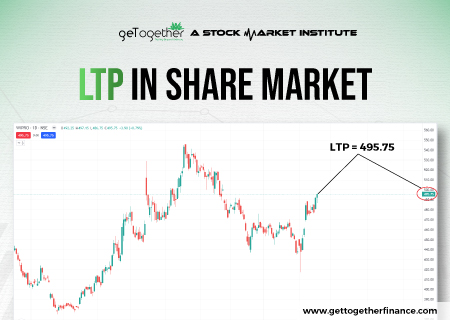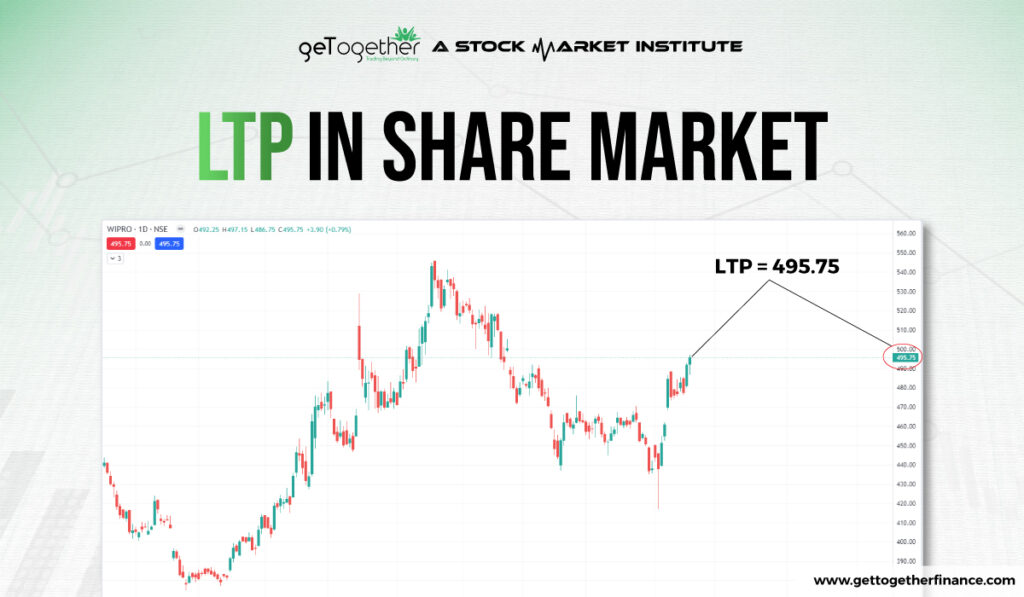LTP in Share Market


Table of Contents
ToggleOverview
If you’re new to trading, the jargon can be pretty overwhelming at first. Many terms seem similar but actually mean quite different things. Getting a grip on these terms is crucial if you want to ace the stock market.
One term that often causes confusion is the last traded price or LTP. Many people mistake it for the closing price or the market price, but they’re not the same. This blog dives deeper into understanding what the last traded price really means, including its importance and the process of calculation. So without further ado, let’s start with.
What is LTP in The Share Market

LTP, or Last Traded Price, is a key term in the share market that refers to the price at which a stock was last bought or sold. It represents the most recent transaction price of a security and is frequently updated throughout the trading day.
Unlike the closing price, which is the final price at the end of the trading session, the LTP fluctuates as trades occur. LTP shows the final price of a lump sum transaction where a buyer and seller agree on a fixed number of shares at a set price. The transaction value is determined by the number of shares involved.
It offers a way for investors to gauge the most recent trading value of a stock, offering an alternative for those looking to make quick gains without engaging in continuous trading. The LTP usually ends with decimal points such as .00, .01, .02, etc., reflecting the precise trading value. It does not account for bonuses or dividends declared on that particular day.
LTP strictly represents the last traded price of the shares for that day, similar to the closing price or end-of-day price.
How is LTP Calculated in The Share Market

The Last Traded Price (LTP) in the share market is calculated based on the most recent transaction of a particular stock. Here’s how it works:
- Real-Time Trading Data: The stock exchanges, such as NSE or BSE in India, continuously track and update the prices at which stocks are bought and sold throughout the trading session.
- Final Transaction Price: The LTP is the price at which the last trade of a particular stock occurred. This means that every time a trade is executed, the LTP is updated to reflect the price of that transaction.
- Order Matching System: The exchanges use an order matching system where buy and sell orders are matched based on price and time priority. When a buy order matches a sell order, a trade occurs, and the price at which this trade happens becomes the LTP.
- Continuous Update: As trading continues throughout the day, the LTP keeps changing with each new transaction. The final LTP at the end of the trading session represents the last transaction price before the market closed.
- Trading Platforms: Investors can view the LTP on various trading platforms and financial news sites, which provide real-time data and updates from the stock exchanges.
Example Calculation of LTP
Let’s take an instance using the following sequence of trades for Stock ABC during a trading session:
- Trade 1: 100 shares sold at ₹150
- Trade 2: 50 shares sold at ₹152
- Trade 3: 200 shares sold at ₹151
- Trade 4: 75 shares sold at ₹153
After Trade 1, the LTP is ₹150.
After Trade 2, the LTP is ₹152.
After Trade 3, the LTP is ₹151.
After Trade 4, the LTP is ₹153.
The LTP at the end of the trading session is ₹153, which is the price at which the last trade occurred.
Formula of LTP

While there’s no mathematical formula to calculate LTP (since it’s simply the price of the last executed trade), understanding the underlying process is crucial. Here’s a simplified representation:
LTP = Price of Last Executed Trade
Where:
- LTP: The last traded price, updated with each transaction.
- Order Matching: The exchange matches buy and sell orders based on price and time priority.
- Real-Time Update: LTP changes continuously as trades are executed.
Importance of LTP in Stock Markets

Last Traded Price (LTP) is essential for investors, traders, and other market participants. Here’s why LTP holds significant importance in the stock markets:
Real-Time Indicator of Stock Price
LTP provides the most recent price at which a stock was traded, offering a real-time snapshot of its market value. It helps investors and traders make informed decisions based on the latest market activity.
Benchmark for Trading
For traders, LTP serves as a critical benchmark. It helps them decide on entry and exit points for their trades. Knowing the LTP allows them to evaluate the current market conditions and plan their strategies accordingly.
Price Transparency
LTP enhances market transparency by reflecting the price at which the most recent transaction occurred. This information is crucial for maintaining fair and open markets, ensuring that all participants have access to the same data.
Market Sentiment Indicator
The LTP can indicate the market sentiment towards a particular stock. A rising LTP may suggest a bullish sentiment, while a falling LTP may indicate a bearish sentiment. This helps investors gauge the market’s mood and adjust their strategies.
Valuation and Pricing
Investors use the LTP to assess the current value of their holdings. It is also used by analysts and portfolio managers to compare stocks and determine whether they are overvalued or undervalued based on their latest trading price.
Basis for Calculating Index Values
LTPs of constituent stocks are used to calculate various stock market indices. Changes in the LTPs of major stocks directly impact the index values, which are indicators of overall market performance.
Execution of Market Orders
When placing market orders, the LTP helps traders understand the price at which their orders are likely to be executed. This is crucial for achieving desired trade outcomes and managing potential slippage.
Comparison with Other Prices
LTP is often compared with other prices like opening price, closing price, and average price. Such comparisons help traders and analysts identify trends, patterns, and anomalies in stock price movements.
Volatility Measurement
Frequent changes in LTPs indicate high volatility, while stable LTPs suggest lower volatility. This information is vital for risk management, allowing traders to adjust their positions according to market stability.
Regulatory and Reporting Purposes
LTP is used in regulatory filings and financial reports. It provides a reference for compliance with various market regulations and standards, ensuring accurate and transparent reporting.
Also Read: Position Trading
Closing Price vs LTP

In the stock market, both the Closing Price and the Last Traded Price (LTP) play critical roles in decoding a stock’s performance, but they serve different purposes. The Closing Price is the final price at which a stock is traded at the end of a trading session and is a key reference for evaluating a stock’s daily performance.
On the other hand, the Last Traded Price (LTP) represents the most recent transaction price during the trading session, offering real-time insights into the stock’s current market value. LTP is continuously updated as trades occur, making it essential for traders who need the latest information to make quick decisions.
Other metrics are important, but they cater to different needs: the Closing Price for end-of-day analysis and historical comparison, and LTP for real-time trading decisions and understanding market trends. Here is a quick table of comparison to know the difference between the closing price and LTP:
| Aspect | Closing Price | Last Traded Price (LTP) |
| Definition | Final price at session end | Most recent price during session |
| Timing | End of trading day | Continuously updated |
| Significance | Daily performance, historical comparison | Real-time trading decisions |
| Stability | Constant until next session | Fluctuates with each trade |
| Usage | Financial reports, historical analysis | Immediate trading, market sentiment |
| Impact on Trading | Benchmark for next day | Executing market orders, strategies |
| Example | Final price of ₹150 | Latest trade at ₹150 |
Conclusion
The Indian stock market thrives on information and real-time movement. By incorporating the Last Traded Price (LTP) into your investment strategy, you gain a valuable tool for understanding investor sentiment and making informed decisions. Remember, LTP is the lifeblood of a stock’s current value, constantly pulsing with the latest transactions. Use it to measure market interest, identify potential opportunities, and make timely choices about buying, selling, or holding your stocks. It is vital to always conduct your research, consider other market factors, and develop a comprehensive investment strategy before taking action.
FAQs
How can I track LTP?
Most online brokerage platforms and financial websites display LTP information for various stocks in real time. You can also access LTP data through mobile apps offered by stock exchanges.
Does LTP predict the future price of a stock?
No, LTP doesn’t guarantee a stock’s future performance. While a rising LTP might suggest positive sentiment, it’s crucial to conduct thorough research before making investment decisions.
Is LTP the only factor I should consider when buying or selling a stock?
Absolutely not! LTP offers valuable real-time insights, but it’s just one piece of the puzzle. Always consider your investment goals, and risk tolerance, and conduct comprehensive research before making any investment decisions.
Is LTP helpful for short-term trading?
LTP’s real-time nature allows you to potentially spot sudden price movements and identify short-term trading opportunities. However, remember that successful trading requires a robust strategy beyond just LTP. You can club the data with foolproof technical theories such as demand-supply or support-resistance and equip your trading set-up.
What is the full form of LTP?
LTP full form in the Last Trading Price, is a key term in the share market that refers to the price at which a stock was last bought or sold.



 Facebook
Facebook Instagram
Instagram Youtube
Youtube
